You may have heard of the “Balik Probinsya, Bagong Pag-asa” (BP2) Program of the Philippine government. As the name itself says, this program involves the return or relocation of Filipino families from urban areas to their home provinces. The goal of this program is to decongest Metro Manila and other highly-urbanized areas, as well as to promote rural development.
Also read: OWWA Balik Pinas Balik Hanapbuhay Livelihood Program for OFWs
But aside from that, let’s not forget the second part of the program name: “Bagong Pag-asa.”
Indeed, the BP2 Program is not just about relocating families back to their home provinces. It’s about giving them the chance to build a better life while helping to achieve “balance” between urban and rural development across the Philippines.
Contents
- What is Balik Probinsya, Bagong Pag-asa Program?
- What is the legal basis for the program?
- Who Implements the Balik Probinsya Program?
- Types of Assistance Under the Program
- Qualifications
- Requirements
- How to Process Balik Probinsya PH Program
- How to Apply for Balik Probinsya Program Online
- Programs, Activities, and Projects
- Video: Balik Probinsya Success Story in Leyte
- Frequently Asked Questions
- 1. What is Balik Probinsya, Bagong Pag-asa? (h3)
- 2. What is the legal basis for the program? (h3)
- 3. Who implements the BP2 Program? (h3)
- 4. What are the types of assistance offered by the program? (h3)
- 5. Who are eligible or qualified for the program? (h3)
- 6. What are the requirements to join the program? (h3)
- 7. How to apply for the program?
- 8. What are the programs, activities, and projects involved?
- Summary
- Contact Information: BP2 Depot (h2)
- Google Map Location
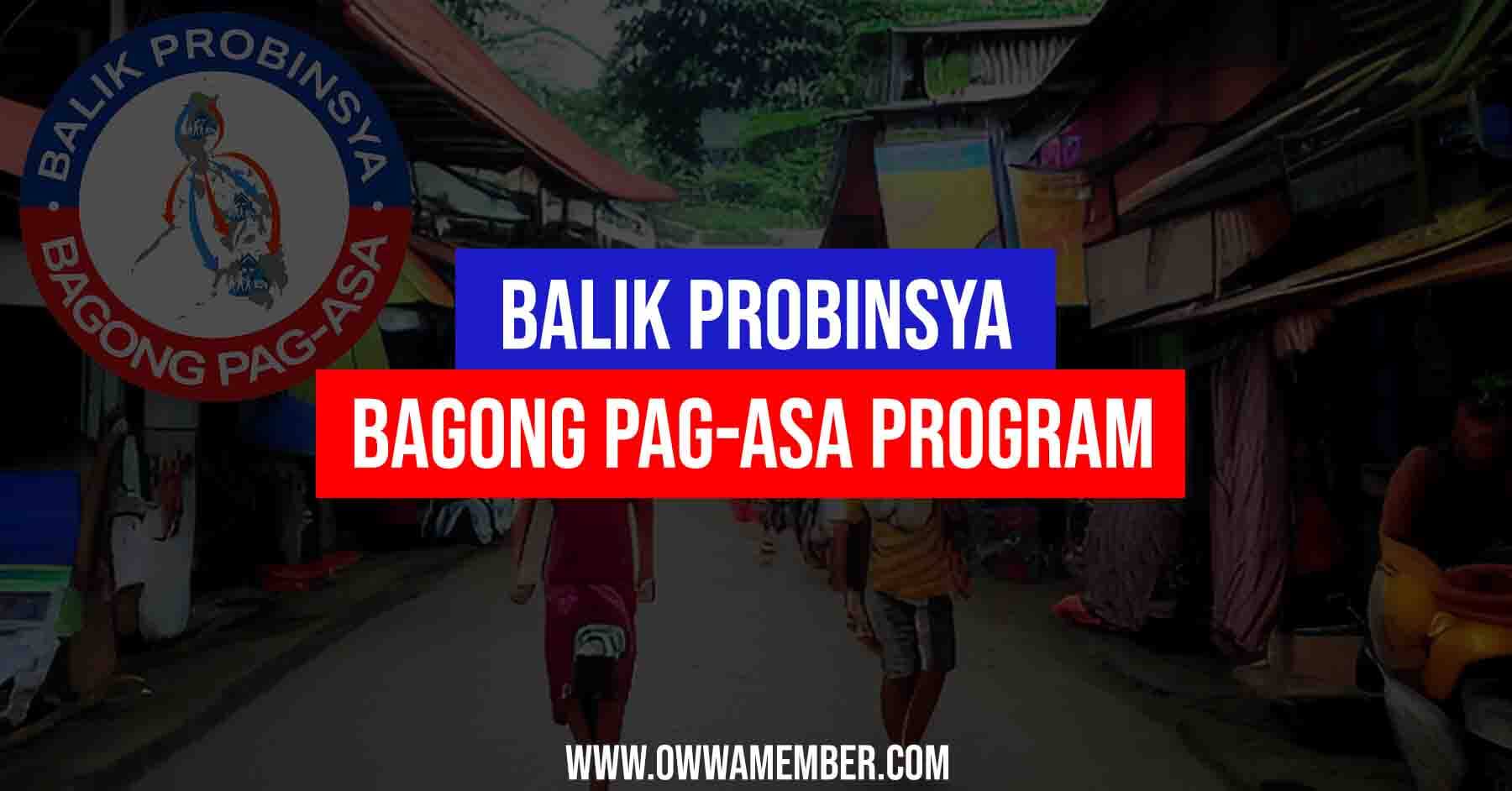
What is Balik Probinsya, Bagong Pag-asa Program?
In a nutshell, Balik Probinsya, Bagong Pag-asa (BP2) is a program that seeks to boost countryside development, while providing a better future for urban poor Filipinos by encouraging them to return to their home provinces.
Aside from offering transportation assistance, the program also includes housing, livelihood, education, subsistence, and other types of incentives.
In the long run, the BP2 Program aims to improve four key areas: (a) empowerment of local industries; (b) food security and agricultural productivity; (c) development of infrastructure; and (d) social welfare, health, and employment.
What is the legal basis for the program?
It was enacted through Executive Order (EO) No. 114, also known as an order “Institutionalizing the Balik Probinsya, Bagong Pag-asa Program as a Pillar of Balanced Regional Development, Creating the Balik Probinsya Council, and for Other Purposes.” It was signed by former President Rodrigo Roa Duterte on May 6, 2020.
As mentioned earlier, the program aims to help “decongest” Metro Manila and other urban areas by offering people the chance to start anew in their home provinces. Beneficiaries of the program can expect to receive comprehensive services, including: transportation or relocation assistance, livelihood settlement grants, emergency family assistance, psychosocial support, and other interventions.
Who Implements the Balik Probinsya Program?
The BP2 Program is implemented by the Department of Social Work and Development (DSWD), together with other agencies. These include:
- Department of Transportation (DOTr);
- Department of Agriculture (DA);
- Department of Education (DepEd);
- Commission on Higher Education (CHED);
- Technical Education and Skills Development Authority (TESDA);
- Department of Health (DOH), Department of Labor and Employment (DOLE);
- Department of Trade and Industry (DTI); and
- National Housing Authority (NHA), among others.
As you can see, the BP2 program is a multi-departmental effort. Notably, since the program was implemented in 2020, it has aided more than 4,300 urban poor families in relocating to their home provinces.
Types of Assistance Under the Program
What types of assistance does the BP2 Program provide? These will depend on the assessment of DSWD’s social workers for each case. Nonetheless, program beneficiaries can expect to benefit from one (or more) of these services:
- Transportation or Relocation Assistance – This amounts to PHP 3,000 to PHP 35,000 for each family who will move from their current residence to their destination.
- Transitory Family Support Package – This includes PHP 10,000 to PHP 70,000 to cover food and non-food items (e.g. clothes, hygiene kits, cooking/eating utensils, first aid kits, school supplies, etc.) needed by the family during their transition.
- Livelihood Settlement Grant – This amounts to a maximum of PHP 50,000 as capital for establishing or continuing a livelihood activity. This will be administered through the DSWD’s Sustainable Livelihood Program or SLP.
- Transitory Shelter Assistance – This includes PHP 120,000 to PHP 250,000 as rental subsidy per year (for up to two years), while the family waits for National Housing Authority (NHA) housing to be built and/or awarded.
- Psychosocial Support – This involves dialogue sessions and meetings with the family, as part of the preparations for their reintegration to their home province.
Aside from the above, the community where the family will relocate may also receive a municipal grant for basic services, capacity building intervention, and social preparation activities for BP2 Program beneficiaries. These will be based on the assessment of the DSWD, in coordination with local social welfare officers.
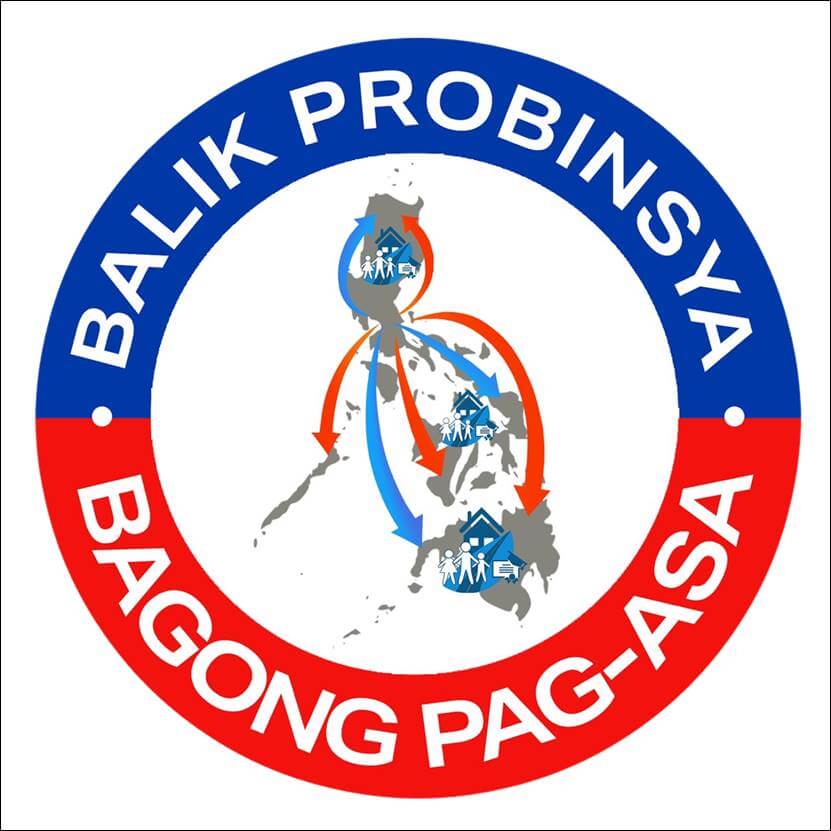
Qualifications
Who are eligible or qualified to join Balik Probinsya, Bagong Pag-asa? Basically, the program is open to all eligible Filipinos who are seeking to start a new life in the provinces. Priority is given to:
- Informal settlers;
- Families living on the street or in danger zones;
- Families affected by government projects and legal demolition activities;
- Individuals who lost employment or income opportunities;
- Victims of human-induced or natural disasters, including health hazards (e.g. COVID-19 pandemic); and
- Families who belong to the marginalized, disadvantaged, or vulnerable sectors.
Requirements
To join the program, applicants need to prepare these documents:
- Balik Probinsya, Bagong Pag-asa Application Form;
- Barangay Certificate of Residency or Indigency; and
- Any government-issued Valid ID.
NOTE: Depending on the destination and the current health protocols, you may also need to prepare a Travel Clearance and Health Certificate.
How to Process Balik Probinsya PH Program
If you would like to join the Balik Probinsya, Bagong Pag-asa (BP2) Program, there are two ways to apply: online or in-person.
- Online Processing – To apply online, visit the Balik Probinsya official website and answer the application form (more on this below) here – http://www.balikprobinsya.nha.gov.ph/
- On-Site Processing – Meanwhile, if you don’t have Internet access or if you’d rather apply on-site and in-person, go to the nearest Barangay office or DSWD office. If you are in the National Capital Region (NCR), you can go to the BP2 Depot, which is located in Quezon City. They will guide you with regards to answering forms and preparing requirements.
The DSWD will then verify and assess all applications, before preparing assistance packages. Once approved, you will receive a call from a BP2 Representative through your telephone, mobile number, email, or social media accounts.
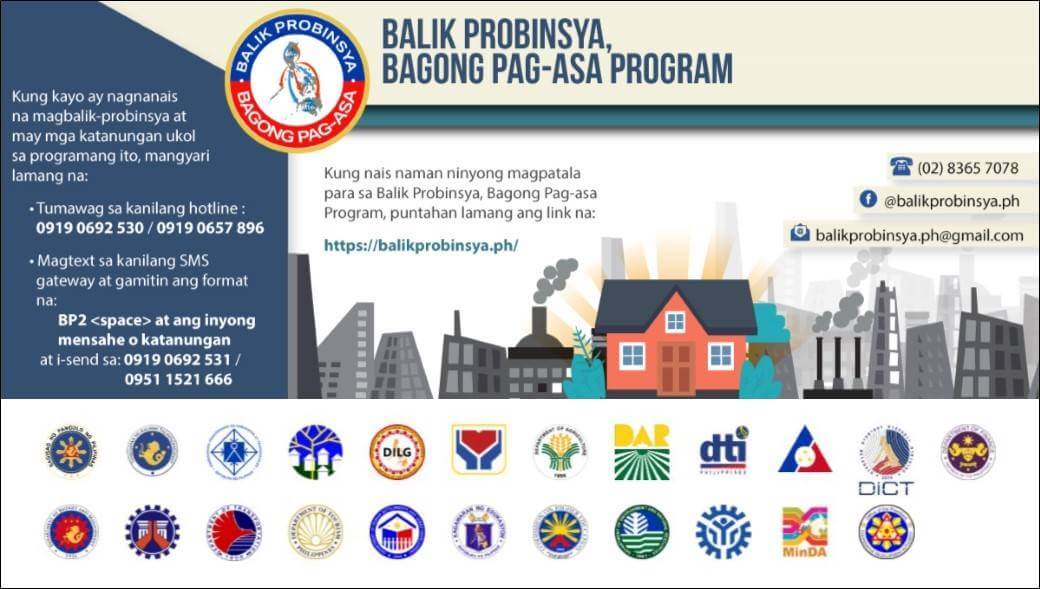
How to Apply for Balik Probinsya Program Online
One of the ways you can join the BP2 Program is by applying online. Simply follow this step-by-step guide:
- Go to the Balik Probinsya official website. http://www.balikprobinsya.nha.gov.ph/
- On the homepage, click “Apply.” You will be directed to the Balik Probinsya Form.
- Enter your personal information: full name, date of birth, gender, civil status, educational attainment, current address, contact information, Social Security System (SSS), Taxpayer Identification Number (TIN), and other details.
- Enter details about your destination: provincial address, your reason for applying, and number of family members (if any) who are traveling with you.
- Enter the details of three of your contact persons (e.g. head of the family, spouse, friend/family), including their full names and contact numbers.
- Answer several “assessment” questions regarding your destination, plans for work or business, technical skills that you want to learn, and other details.
- Read the terms and conditions, then click “Agree.”
- After completing the form, click “Submit.”
That’s it! Now all you have to do is to wait for an email or call from a BP2 Representative. He/She will give further instructions regarding your application.
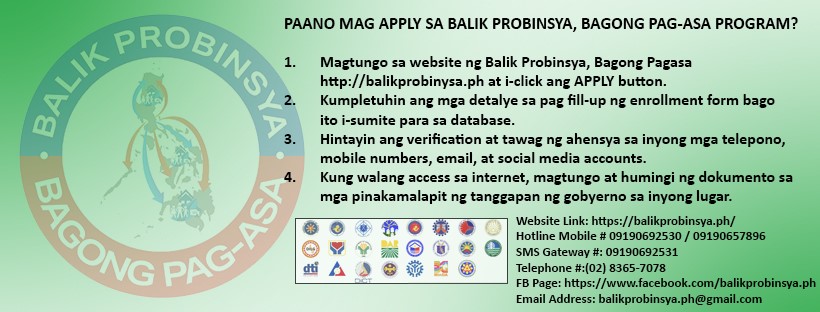
Programs, Activities, and Projects
Once your application has been approved, the BP2 Representative will provide instructions and details regarding your travel back to your home province.
But the program doesn’t stop with just relocation. BP2 has short-term, medium term, and long-term programs, activities, and projects for all beneficiaries. Here is a quick run down of each progress phase:
Short Term Activities
These are immediate activities that focus on the relocation of families to their home provinces, along with reintegration programs:
- Transportation and relocation;
- Coordination with Local Government Units (LGUs);
- Transitory support services;
- Agri-based support services;
- Livelihood and employment packages;
- Educational programs; and
- Fiscal incentives and transition assistance for Micro, Small and, Medium Enterprises (MSMEs).
Medium Term Projects
Alongside short-term activities, medium-term projects are also being done, such as:
- Identification of existing special economic zones and development of MSME-oriented industries;
- Establishment of new special economic zones in Visayas and Mindanao, including the Bangsamoro Autonomous Region;
- Livelihood and employment opportunities suitable for rural development;
- Strengthening and prioritizing the National Spatial Strategy, which is integrated in the Philippine Development Plan;
- Integration of institutional assistance, such as: progression of formal education; improvement of healthcare services and medical facilities; promotion of peace, order, and security.
Long-Term Programs
Aside from short-term and medium-term activities, the following long-term programs shall also be achieved:
- Decentralization of powers and seat of governance;
- Priority legislation on rationalized and results-based tax incentives for agricultural or tourism industries and the National Land Use Act; and
- Establishment of new urban centers outside the NCR and existing major cities.
Video: Balik Probinsya Success Story in Leyte
Here is a video shared by the Philippine News Agency (PNA), featuring a BP2 Program success story. It tells the story of a man who relocated from Manila to Leyte province because of the COVID-19 pandemic. From earning a meager salary in the city before, he now operates a successful livestock business in the province:
Frequently Asked Questions
Meanwhile, here are some frequently asked questions and answers about the Balik Probinsya, Bagong Pag-asa Program:
1. What is Balik Probinsya, Bagong Pag-asa? (h3)
Balik Probinsya, Bagong Pag-asa (BP2) is a program of the Philippine government that encourages people in Metro Manila and other cities to return or relocate to their home provinces. It also seeks to attain balance between urban and rural development across the country by providing different types of assistance to beneficiaries, as well as to the communities where they have relocated.
2. What is the legal basis for the program? (h3)
The BP2 program was enacted through Executive Order No. 114, which is also known as an order “Institutionalizing the Balik Probinsya, Bagong Pag-asa Program as a Pillar of Balanced Regional Development, Creating the Balik Probinsya Council, and for Other Purposes.” The order was signed on May 6, 2020 by then President Rodrigo Roa Duterte.
3. Who implements the BP2 Program? (h3)
Balik Probinsya, Bagong Pag-asa is a program that invoves not just one, but several government agencies. Basically, it is implemented by the Department of Social Work and Development (DSWD), although other departments also play a major role, such as the Department of Transportation (DOTr), Department of Agriculture (DA), Department of Education (DepEd), Commission on Higher Education (CHED), Technical Education and Skills Development Authority (TESDA), Department of Health (DOH), Department of Labor and Employment (DOLE), Department of Trade and Industry (DTI), and National Housing Authority (NHA).
4. What are the types of assistance offered by the program? (h3)
There are different types of assistance offered by the program, depending on the need(s) of the beneficiary, as well as the assessment of DSWD. The beneficiaries may benefit from one or more of the following services: (a) transportation or relocation assistance; (b) transitory family support package; (c) livelihood settlement grant; (d) transitory shelter assistance; and (e) psychosocial support.
In addition, the community where the beneficiaries will relocate may also receive support in the form of a municipal grant for basic services, capacity building intervention, and social preparation activities for program beneficiaries.
5. Who are eligible or qualified for the program? (h3)
The BP2 program caters to urban poor families in Metro Manila and other major cities, particularly those who: (a) are informal settlers; (b) are living on the street or in danger zones; (c) are affected by government projects and legal demolition activities; (d) have lost employment or income opportunities; (e) are victims of human-induced or natural disasters, including health hazards (e.g. COVID-19 pandemic); and (f) belong to the marginalized, disadvantaged, or vulnerable sectors.
6. What are the requirements to join the program? (h3)
To join the program, applicants must fill up the Balik Probinsya, Bagong Pag-asa Form, as well as present a Barangay Certificate of Residency (or Indigency), and any valid, government-issued ID. Depending on the latest health protocols, applicants may also need to prepare a Health Certificate and Travel Certificate.
7. How to apply for the program?
There are two ways to apply for the BP2 Program. You can apply online through the Balik Probinsya official website. You can also apply by going personally to the nearest Barangay office, DSWD office, or to the BP2 Depot in Quezon City.
http://www.balikprobinsya.nha.gov.ph/
8. What are the programs, activities, and projects involved?
The BP2 program is implemented in three phases. First, there’s the short-term phase which includes transportation, relocation, and support services including livelihood and educational programs. Meanwhile, the medim-term phase involves the establishment of special economic zones in Visayas and Mindanao, along with improvement of healthcare services and medical facilities. Finally, the long-term phase involves the decentralization of powers and seat of governance, and the establishment of new urban centers outside the NCR and existing major cities.
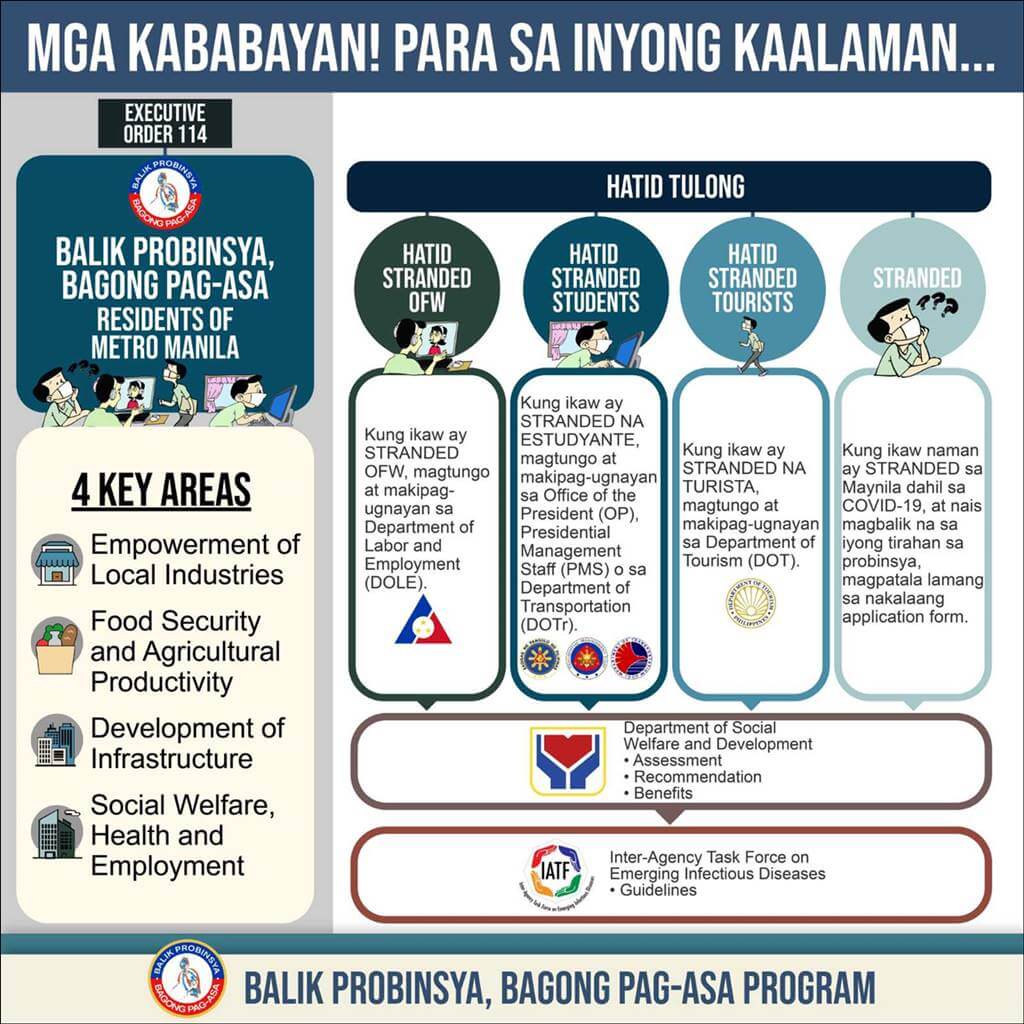
Summary
The Balik Probinsya, Bagong Pag-asa (BP2) Program is a great initiative, especially since it has a two-fold goal: to decongest major cities like Metro Manila, while focusing on the development of provinces across the Philippines.
It cannot be denied that overpopulation is a major concern, especially in our cities. Fortunately, by giving people the chance to start anew in the rovinces, we can expect the BP2 program to achieve greater balance between urban and rural development as well.
Contact Information: BP2 Depot (h2)
If you want to know more about the program, you can get in touch with the Balik Probinsya, Bagong Pag-asa (BP2) Depot through the following contact details:
BP2 Depot
Address: 86 Quezon Ave, Diliman, Quezon City, 1100 Metro Manila
Telephone: (02) 8365 7078
Mobile: 0919 069 2530 / 0919 065 7896 / 0919 069 2531
Email: balikprobinsya.ph@gmail.com / balikprobinsya@dswd.gov.ph
Website: https://balikprobinsya.nha.gov.ph/
Facebook: https://www.facebook.com/balikprobinsya.ph
Google Map Location
Meanwhile, here is the location of the Balik Probinsya, Bagong Pag-asa (BP2) Depot on Google Maps, for your reference:
DISCLAIMER: We hope that the above guide has been helpful, especially if you or anyone you know is interested in joining the Balik Probinsya, Bagong Pag-asa (BP2) Program. Please note that this guide is presented for general, information-sharing services only. To learn more about the latest requirements and steps in joining the program, please visit BP2’s official website and Facebook page.